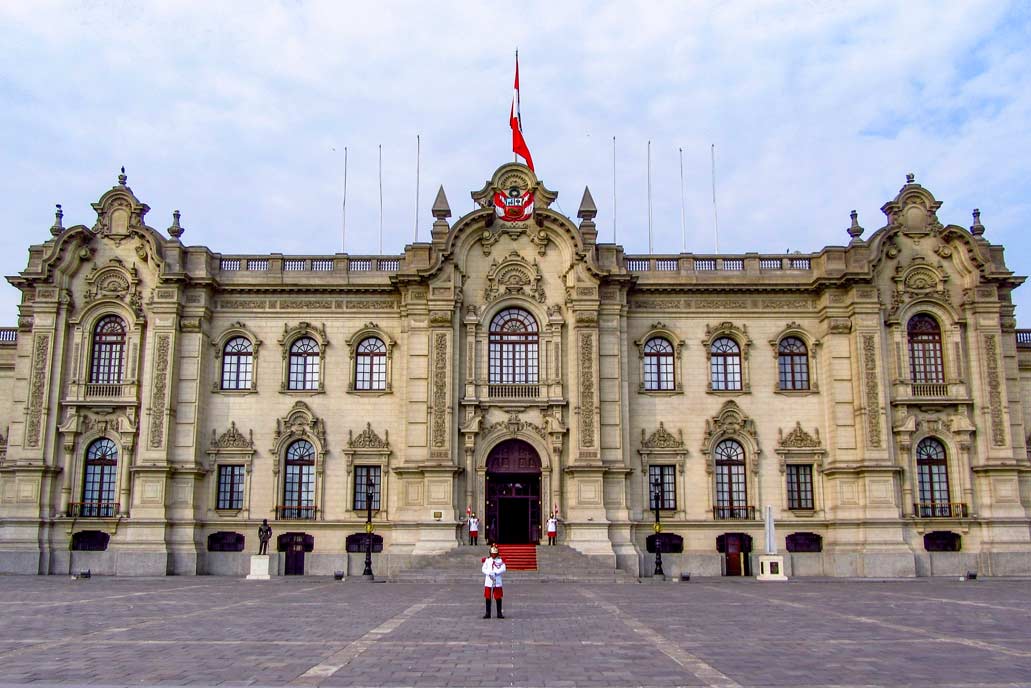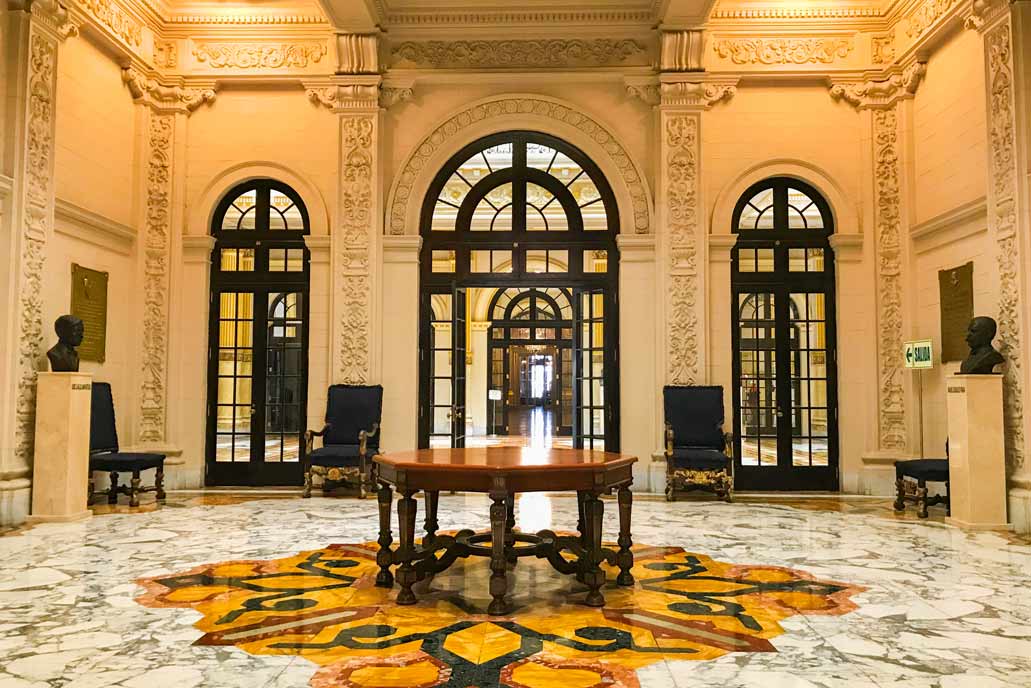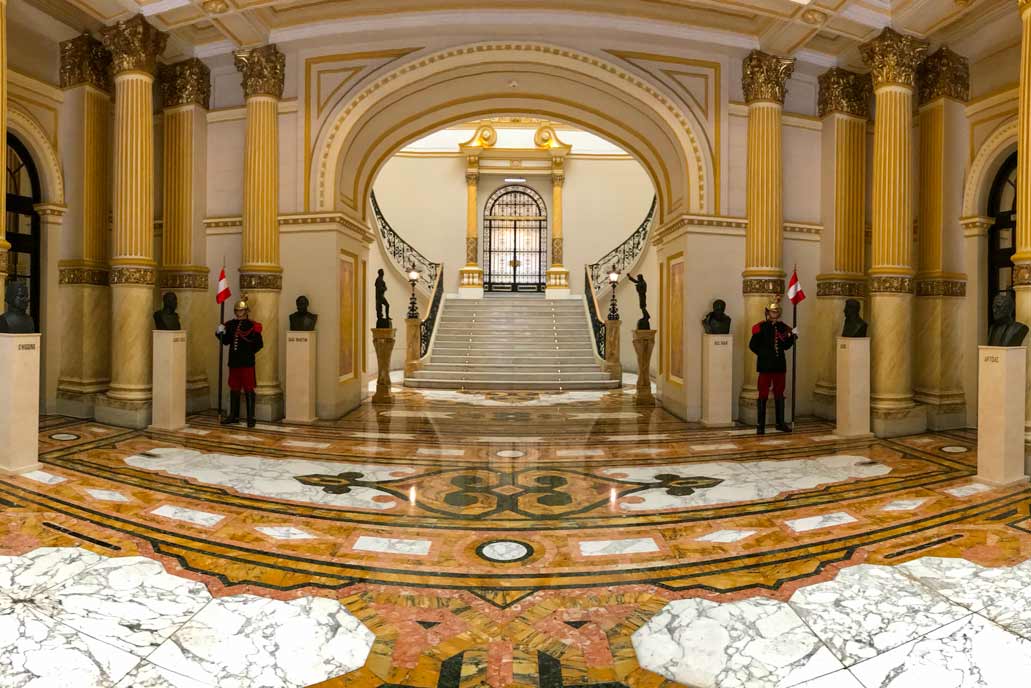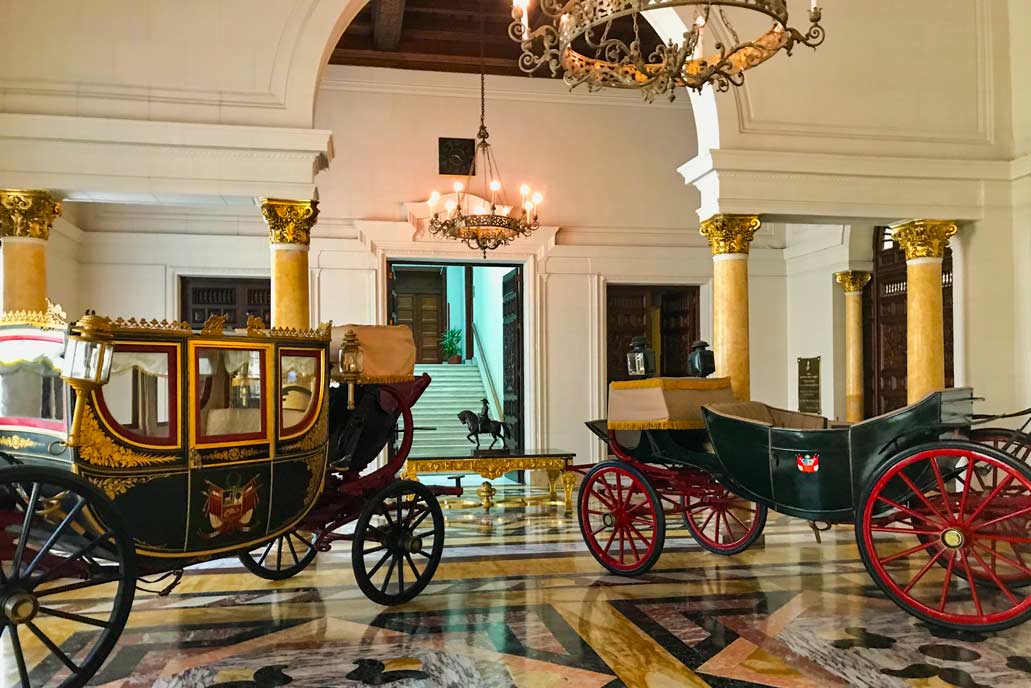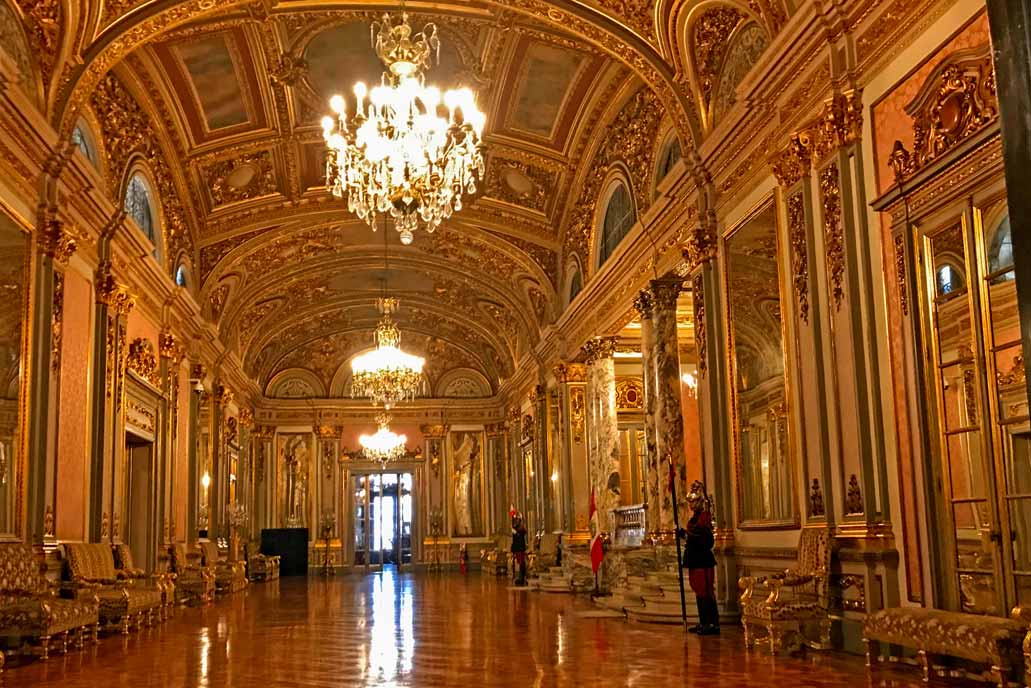History and Attractions of the Government Palace of Peru
In recent years, the Government Palace has decided to open its doors to all Peruvians. This building has undergone many renovations to reach the state in which it can be seen today when visiting Lima’s historic center. This residence represented the place where power was exercised over Peruvian territory, starting with Pizarro, continuing through the viceroys, and later, after Peru’s independence, the presidents. Due to its historical significance, this monumental building holds special importance, making it a must-visit site.
Contents
History of the Government Palace of Peru
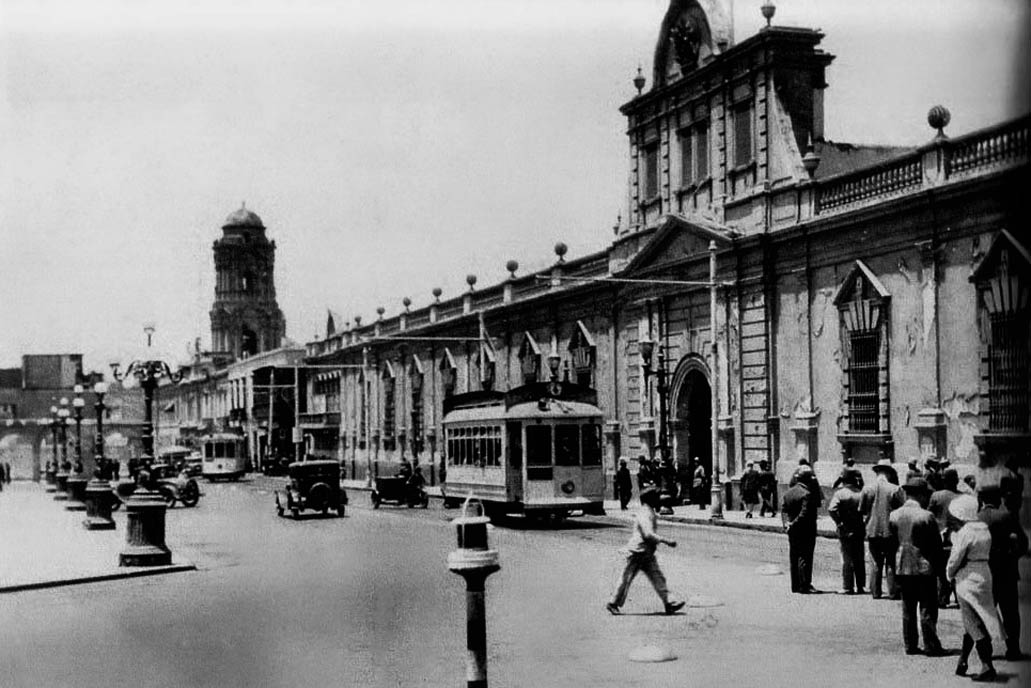
Pizarro’s House
During the distribution of the conquered lands, Pizarro acquired much of the Palace of Tauclichisco, who at that time ruled the Rimac River basin. This Curaca served the Incas and, after the conquest, had no option for resistance, so Pizarro ordered his residence to be built on this site. It is said that the Inca construction featured beautiful gardens, orchards, and fruit trees. Like all Inca buildings, it was an important communication point with other towns. After these records made by some chroniclers, no further information exists about this old curaca.
All the premises of this palace were replaced to build a new Spanish city. Many cultivated areas were not preserved, and even some homes of native inhabitants were destroyed and repurposed for the construction of new buildings. Among these new constructions was Pizarro’s house.
This first building had simple details, was not very ostentatious, but maintained the characteristics of Andalusian houses, with large adobe courtyards and spaces dedicated to stables. Initially, the Royal Fifth was stored in Pizarro’s house. On June 26, 1541, Pizarro was assassinated, and his house was looted by the Knights of the Cape, commanded by the Almagristas after the Battle of Salinas. One detail that remains from the original design is the staircase parallel to Palacio Street, where it is said that Pizarro himself planted a fig tree; both elements can still be seen today.
Little is known about his origins and history before the Spanish arrived in his curacazgo. According to testimonies from indigenous people collected by viceregal authorities, Taulichusco was a “yanacona and servant of Mama Vilo, wife of Huayna Cápac.” He was an authority imposed by the Incas of Cusco in the valley.
During the Viceroyalty
After Pizarro’s death and the social instability caused by the civil war, the Spanish Crown claimed the conqueror’s lands due to a debt of 28,000 pesos of gold that he owed. Because of this debt, the Royal Treasury took possession of the property. Due to its location and some existing functions, it was established as the residence of Peru’s first viceroy, Blasco Núñez Vela. From this viceroy onward, successive viceroys renovated and transformed the place into a true monument or palace. The viceroy who made the most changes and improvements was Francisco de Toledo, known as the Count of Oropesa. He lived in this new building until 1581.
In 1586, a strong earthquake destroyed much of the improvements that had been made. As a result, the viceroy at the time had to rebuild a new Viceregal Palace. The viceroy Luis de Velasco y Castilla was in charge of this mandate. Since then, it stood out from the rest of the buildings of that time. For example, in the early 17th century, Bernabé Cobo wrote about the construction: “It is the largest and most sumptuous house in this Kingdom, due to its large site and the many costly buildings that all the viceroys have added to it.”
At the Church of La Soledad, there is a painting depicting the façade of the mentioned building. In this painting, a Holy Week procession is shown with the new construction in the background. However, another earthquake destroyed much of the façade in 1687, and another in 1746. Although they were rebuilt, they did not have the same elegance as the first construction of the Viceroys’ Palace. Another problem arose in 1769 when a fire caused the loss of valuable objects and important documents. After this incident, attempts were made to restore and modify some parts, but the damage seemed irreparable. One of the changes that remains today is the one ordered by viceroy Francisco Gil de Taboada: the entrance over Palacio Street.
During the Republic
After the independence forces defeated the Spanish forces commanded by the last viceroy, José de la Serna, San Martín briefly settled in the Viceregal Palace. In the early years of the Republic, it was used intermittently until it was finally designated as the residence of Peru’s new leaders. During Marshal Ramón Castilla’s government, it received many improvements and decorations with artworks. In 1865, Vice President Antonio Pezet ordered the construction of the Crystal Dining Room, designed by Swiss architect Michele Trefogli.
Years later, during the War of the Pacific against Chile, the Chilean army occupied the Peruvian capital from 1881 to 1883. Peace was only achieved through the Treaty of Ancón. It is said that before leaving the Government Palace, the Chilean army looted its main decorations. They took two cannons from the entrance flanks, portraits of viceroys and presidents, various furniture, carpets, and lamps. Some artworks were either burned or taken to Chile.
After the treaty, Miguel Iglesias became president and proposed restoring the palace’s former splendor. However, in 1884, an unexpected fire once again destroyed many documents related to 16th-century tributes. After these setbacks, President Andrés Avelino Cáceres initiated restoration efforts.
During Nicolás de Piérola’s presidency (1895 – 1899), a new façade restructuring began. Open balconies were added at the ends, now known as the parade balconies.
From the 20th Century to the Present
Years later, during Augusto Leguía’s government (1919 – 1930), a new building was constructed. Some previous structures remained, including the Honor Gate and the Inca Hall, which is decorated with papier-mâché figures depicting daily Inca life, along with other modernist sculptures and reliefs. The new buildings were designed in a neocolonial style by French architect Claude Sahuy Laurent.
These finishes can be found in the halls surrounding the entrance hall. Two halls, the Eléspuru Hall and the Choquehuanca Hall, were dedicated to two soldiers who died in a revolt during Piérola’s government, right at the entrance of the Government Palace. Other spaces designed by the architect include the Pizarro Room, the Presidential Office, and the Golden Hall.
For major events, such as the visit of the Prince of Wales, some presidents continued construction despite the 1929 global economic crisis. The most notable contributions were by President Sánchez Cerro, who completed the presidential office, the Louis XVI Hall, and the Ministers’ Hall. Later, President Óscar Benavides finished pending works from the previous administration. During these renovations, the last walls of Pizarro’s house were demolished.
Since 1938, the Government Palace has had its current appearance. Subsequent presidents made only interior and decorative changes.
What Can Be Seen at the Government Palace?
Within its more than 19,000 square meters, the palace features various spaces dedicated to multiple purposes. The most well-known are the halls, followed by the well-maintained gardens, the grand dining room, and other attractions. All these spaces are finely decorated with works of art and French-inspired architectural finishes, making this palace one of the most beautiful government headquarters in the Americas.
Halls of the Government Palace
Grand Main Hall
This hall is one of the most striking and connects two other halls. It features Roman-style columns. The main decorations include busts of the liberators José de San Martín and Simón Bolívar, located at the end of the hallway staircase. Other busts are distributed along the columns, which are adorned with stucco painted with bronze leaves. The vaulted ceiling features stained glass, also inspired by the Roman style. This hall has two levels; it connects to the office where ministers meet and also leads to the Sevillian Patio, which we will discuss below. This level also houses official portraits of former presidents of Peru and other offices related to the presidential office.
Sevillian Hall
This hall has strong Moorish influences, meaning Islamic and Andalusian influences. The space features tiles brought from Seville. These tiles display representations of Francisco Pizarro’s coat of arms, the old coat of arms of Lima, and the current national coat of arms of Peru. It serves as the presidential office; although not very large, the wall decorations with tiles make it a spectacular space.
Sevillian Patio, in this part of the Government Palace, one can find the fig tree planted by Francisco Pizarro. This area also provides access to the Palace Chapel, a place dedicated to Christian worship, which features sculptures of Peruvian saints such as Saint Rose of Lima, Saint Martin de Porres, and Saint John Macias, as well as paintings and a large white cross.
Tupac Amaru Hall
Previously known as the Francisco Pizarro Hall, it was even referred to as “Tupac Pizarro” by President Belaúnde Terry. The name change was made by President Juan Velasco Alvarado. This hall once housed a painting of Francisco Pizarro on horseback (painted by Daniel Hernández). It now features a portrait of Tupac Amaru II (painted by Armando Villegas). Another notable feature of this hall is its spectacular carved wooden dome and a musician’s gallery. Among other attractions, visitors can see bronze sculptures by artist Ramón Mateu, depicting female figures representing the four seasons, each placed in a corresponding niche. The walls also feature high-relief sculptures by artist Daniel Casafranca, showcasing Inca motifs related to daily life and more. The hall’s windows overlook Lima’s Plaza de Armas.
Jorge Basadre Hall
Since 2003, this hall has been named after Jorge Basadre to commemorate the centenary of the birth of the renowned Tacna-born historian. A special place in the hall features a bust of this illustrious Peruvian figure. The sculpture was created by artist Raúl Franco Ochoa. Previously, the hall was known as Eléspuru and Choquehuanca Hall, named after soldiers killed by the Piérolistas during an attempted coup, a situation similar to Pizarro’s assassination. However, in this case, Leguía was rescued. Other decorations include the carriages that were once used for presidential transport.
Marshal Avelino Cáceres Hall
This hall is named in honor of Marshal Andrés Avelino Cáceres, featuring a portrait of him accompanied by two stained-glass windows. Though not a large space, it houses a wooden table surrounded by chairs with fine finishes and Pizarro’s coat of arms, similar to those in the Grand Dining Room. Presidents occasionally use this hall for meetings with ministers or visitors requiring detailed coordination.
Admiral Miguel Grau Hall
This hall contains various decorations honoring Admiral and Congressman Miguel Grau and those who perished during the war with Chile. A portrait of this hero is displayed in a gold-leaf frame. Other details include paintings and a model of the Monitor Huáscar, protected by a glass case that also showcases medals commemorating these historical events.
Golden Hall
This hall was built over the Inca Hall, part of the original Government Palace design. Many experts see a strong resemblance to the Hall of Mirrors in the Palace of Versailles. The entire hall is covered in gold leaf. The vaulted ceiling decorations reference the Andean sky and nature. Many of the furnishings are inspired by the Louis XIV style. The large vaulted ceiling is supported by four marble columns and features four luminous chandeliers. This hall is often used for ministerial swearing-in ceremonies or to grant the Order of the Sun of Peru.
The Order of the Sun of Peru, formerly known as the Order of the Sun, is a special distinction awarded by the Peruvian State. It is granted to individuals who have excelled in various fields such as arts, culture, politics, literature, or for extraordinary services to Peru. Established in 1821, it is the oldest distinction in the Americas.
Francisco Bolognesi Hall
Located between the Ambassadors’ Hall and Grau Hall, this is where the President of the Republic carries out official duties. It is a special space used for handling internal affairs, usually in private meetings with officials. The room is decorated with a colonial-style fireplace and features a portrait of Francisco Bolognesi.
Ambassadors’ Hall
This hall is used to receive ambassadors presenting their credentials for official recognition. It is also sometimes used for meetings with visitors or other heads of state. In 2007, at the initiative of Minister of the Interior Luis Alba Castro, this hall was renamed in honor of Mariano Santos Mateo, a national hero responsible for victory in the Battle of Tarapacá during the war against Chile. A painting of this hero, a replica of his sword, and various honors are displayed in glass cases.
Hall of Peace: This hall was used in 1980 to sign a peace treaty between El Salvador and Honduras, mediated by then-President Fernando Belaúnde Terry and José Luis Bustamante y Rivero.
Great Dining Room of the Government Palace
This is a grand hall featuring a circular table that can accommodate up to 250 guests. It is one of the largest halls, with Baroque finishes that reference the colonial era. The seats are decorated with Pizarro’s coat of arms. The space showcases a coffered ceiling with carved beams and some balconies for musicians. It feels like stepping back in time to the colonial period. One of the most eye-catching features is the crystal chandelier hanging in the center of the hall, weighing nearly a ton and featuring 165 lights. It was custom-made in Czechoslovakia. Other notable details of the Government Palace dining room include six colonial-era paintings, two of which are attributed to artists Jerónimo Cenatiempo and A. Brughel.
By Machupicchu Terra – Last updated, February 14, 2025
